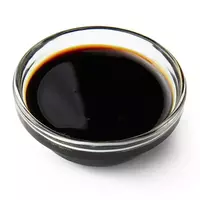Soy marinade

Soy sauce is considered one of the fundamental components of most Asian dishes. The world-famous soy sauce is produced by fermenting or fermenting soybeans. as a rule, the fermentation process takes place under the influence of fungi of the genus Aspergillus. Soy sauce is distinguished by its distinctive brown and black color. The chemical composition of the sauce contains a large number of different mineral elements, as well as substances of natural origin useful for the human body.
However, the taste and consumer characteristics of soy sauce are valued above the beneficial properties. Since the composition of the soy sauce contains glutamic acid derivatives of the compound, the product helps to emphasize the taste of the finished culinary products. Soy sauce appeared in China around the 8th century BC. The researchers believe that initially the soy sauce from the overgrown beans of the soy plant served as a seasoning.
Due to the incredible high cost of the product, soy sauce began to be diluted with water. The updated version of soy sauce quickly gained popularity throughout Southeast Asia. The main feature of soy sauce is that this product is considered the basis for many dishes of the Asian national culinary tradition.
Soy sauce has reached such heights thanks to the umami taste (literally translated from Japanese 旨味 "pleasant"), which appears due to its natural formation during the production of sodium glutamate product. based on soy sauce, many other varieties of Asian sauces and soy marinades are prepared. Soy marinade is thought to work perfectly with fish and vegetable dishes. However, special soy marinades are also used to prepare poultry meat, in which honey and spices are added.
As a rule, in addition to the sauce of the same name, soy marinade can include such ingredients as: mustard, honey, lemon juice, as well as vinegar. In addition, soy marinade is necessarily seasoned with spices and spices. Usually, black peppers and garlic are added to the soy marinade. For fish, a simple and at the same time classic soy marinade is suitable, which includes soy sauce, olive oil, honey and white preferably dry wine.
Asian chefs use soy marinade with ground ginger and garlic to make beef. The meat, lying in a soy marinade, becomes soft, and when cooked, acquires a pleasant tender and aroma. Soy marinade can be used to make barbecue, as well as grilled vegetables. The whole beauty of soy marinade lies in the availability and relative ease of soy preparation, which can significantly improve the taste and flavor characteristics of the culinary products of their meat, vegetables, fish and poultry meat.
soy marinade 187.4 kCal
Energy value of soy marinade (Ratio of proteins, fats, carbohydrates - ju):
Proteins: 2.5 g (~ 10 kCal)
Fats: 0.8 g (~ 7 kCal)
Carbohydrates: 42.7 g (~ 171 kCal)
Energy ratio (bj | y): 5% | 4% | 91%
 Español
Español Français
Français Português
Português Русский
Русский 简体中文
简体中文 繁體中文
繁體中文 日本語
日本語 한국어
한국어 العربية
العربية Türkçe
Türkçe Қазақ
Қазақ Deutsch
Deutsch Italiano
Italiano Українська
Українська
